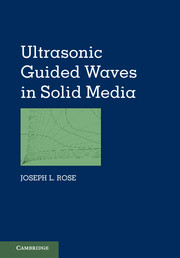Book contents
- Frontmatter
- Contents
- Nomenclature
- Preface
- Acknowledgments
- 1 Introduction
- 2 Dispersion Principles
- 3 Unbounded Isotropic and Anisotropic Media
- 4 Reflection and Refraction
- 5 Oblique Incidence
- 6 Waves in Plates
- 7 Surface and Subsurface Waves
- 8 Finite Element Method for Guided Wave Mechanics
- 9 The Semi-Analytical Finite Element Method
- 10 Guided Waves in Hollow Cylinders
- 11 Circumferential Guided Waves
- 12 Guided Waves in Layered Structures
- 13 Source Influence on Guided Wave Excitation
- 14 Horizontal Shear
- 15 Guided Waves in Anisotropic Media
- 16 Guided Wave Phased Arrays in Piping
- 17 Guided Waves in Viscoelastic Media
- 18 Ultrasonic Vibrations
- 19 Guided Wave Array Transducers
- 20 Introduction to Guided Wave Nonlinear Methods
- 21 Guided Wave Imaging Methods
- Appendix A Ultrasonic Nondestructive Testing Principles, Analysis, and Display Technology
- Appendix B Basic Formulas and Concepts in the Theory of Elasticity
- Appendix C Physically Based Signal Processing Concepts for Guided Waves
- Appendix D Guided Wave Mode and Frequency Selection Tips
- Index
- Plates
- References
12 - Guided Waves in Layered Structures
Published online by Cambridge University Press: 05 July 2014
- Frontmatter
- Contents
- Nomenclature
- Preface
- Acknowledgments
- 1 Introduction
- 2 Dispersion Principles
- 3 Unbounded Isotropic and Anisotropic Media
- 4 Reflection and Refraction
- 5 Oblique Incidence
- 6 Waves in Plates
- 7 Surface and Subsurface Waves
- 8 Finite Element Method for Guided Wave Mechanics
- 9 The Semi-Analytical Finite Element Method
- 10 Guided Waves in Hollow Cylinders
- 11 Circumferential Guided Waves
- 12 Guided Waves in Layered Structures
- 13 Source Influence on Guided Wave Excitation
- 14 Horizontal Shear
- 15 Guided Waves in Anisotropic Media
- 16 Guided Wave Phased Arrays in Piping
- 17 Guided Waves in Viscoelastic Media
- 18 Ultrasonic Vibrations
- 19 Guided Wave Array Transducers
- 20 Introduction to Guided Wave Nonlinear Methods
- 21 Guided Wave Imaging Methods
- Appendix A Ultrasonic Nondestructive Testing Principles, Analysis, and Display Technology
- Appendix B Basic Formulas and Concepts in the Theory of Elasticity
- Appendix C Physically Based Signal Processing Concepts for Guided Waves
- Appendix D Guided Wave Mode and Frequency Selection Tips
- Index
- Plates
- References
Summary
Introduction
Many engineering structures consist of multiple layers. Examples include plates with coatings, painted structures, diffusion bonded or adhesively bonded structures, ice or contaminant accreted aircraft structures, and laminated composites. To achieve long-distance inspection and monitoring of these structures using ultrasonic guided waves, scholars must study the guided wave propagation characteristics in such structures. This chapter examines the wave propagation problem in layered plate structures consisting of isotropic materials. More advanced studies in complicated structures involving material anisotropy and viscoelasticity are addressed later.
Wave propagation in layered plate structures can be abstracted into several models for different layer thicknesses. When a layer thickness is much larger than the selected wavelength, a half-space model can be used to approximate the thick layer. Interface guided wave modes may exist at the interface between two thick materials. In this case, these two layers are modeled as two half-spaces in the classic problems associated with the Stoneley and Scholte wave solutions. When one of the layers is much thicker than the other layers, guided wave modes exist within the thin layers and the upper region of the thick layer. The thick layer can be modeled as a half-space. One classic problem that falls into this category is the Love wave problem, which studies shear horizontal (SH) guided waves in a layer on a half-space. When all of the layers are of compatible thickness, and the wavelengths of the guided waves are also of a compatible scale, a multilayer model can be established by using finite thicknesses for all of the layers.
Information
- Type
- Chapter
- Information
- Ultrasonic Guided Waves in Solid Media , pp. 209 - 245Publisher: Cambridge University PressPrint publication year: 2014
